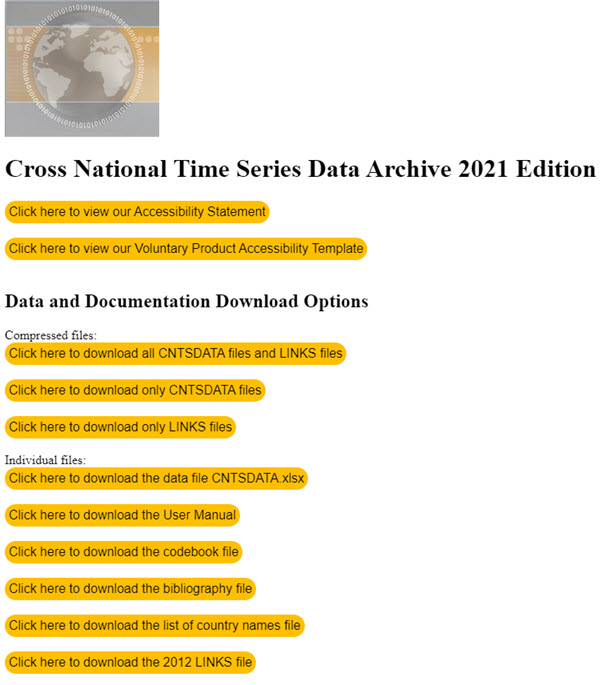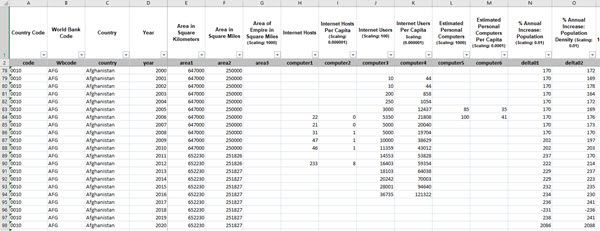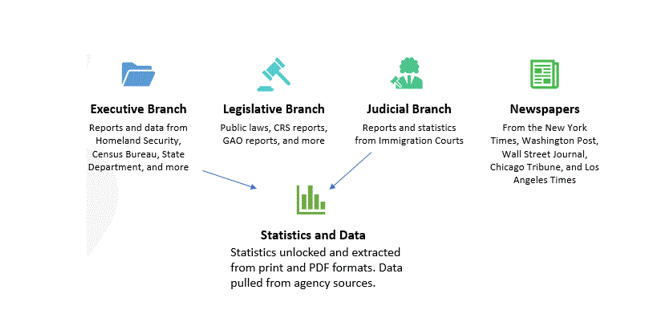The CNTS Data Archive contains annual time series data on 196 political, economic, and business variables from 1815 to the present for over 200 countries. Also includes domestic conflict event data on terrorism and guerrilla warfare, assassinations, revolutions, etc., with links to web articles describing the events. Download the entire dataset in Excel, with separate files for the event links and data documentation.
This is a bit of an odd duck in our database offerings. It is essentially a large Excel file containing the included variables for more than 200 countries, and associated documentation files. Once you hit the database link from the library database list or a research guide, you’ll see a fairly spartan interface with links to download the CNTSDATA file and documentation. There is a section for “compressed files” (which I recommend, and which may require an unzipping utility program–standard on UST computers) that contain the data and documentation files. Or you can download individual files.

You use the main CNTSDATA file by downloading it and exploring the variables within the file itself. Since there are a lot of variables (arrayed across the columns) and a lot of countries and years (arrayed in the rows), the file is both “tall” and “wide”, though not difficult to understand. You can browse or search within the file (using the Find button or Ctrl-F), use column filters (Data>Filter in Excel), or however you like. This is raw data, no graphics, etc., though you can use it however you like within Excel or import it into statistical, data visualization, or other software.

The vendor’s information site has a data categories and variables page that is a little easier to skim to review the variables: you can review that and then jump back to the spreadsheet to find the data. That said, here are the main data categories included:
Area, Computer Usage, Domestic Conflict Events, Economic, Electoral, Energy, Highway Vehicle, Identification, Industrial and Labor Force, Industrial Production, International Status Indicators, Legislative Process, Mail, Media, Military, National Government Revenue and Expenditure, Phone, Physician, Political, Population, Railroad, School Enrollment, Telegraph, Trade, and Urbanization data.
The Domestic Conflict Events data is an interesting additional feature here. The main data file includes counts of the following categories of domestic conflict events: Assassinations, General Strikes, Terrorism/Guerrilla Warfare, Government Crises, Purges, Riots, Revolutions. The database main page includes LINKS files for each year 2012-present that includes open web links to articles describing the event in question (note: some sites like the New York Times may be paywalled, but if necessary, you can access the articles by using LibrarySearch on our home page).
CNTS is used by top universities around the world. The data is compiled from numerous international NGO and historical reference sources, as well as some publisher’s estimates in a complex process, documented in the Bibliography and User Manual files. Their information site also includes a page citing selected papers released using CNTS data.
The data files are updated annually; the newest 2021 update was released in the last month.
Please contact me or my colleague Andrea Koeppe if you have questions about CNTS.
John Heintz | jpheintz@stthomas.edu | 651-962-4646
Andrea Koeppe | arkoeppe@stthomas.edu | 651-962-4647






 Please plan to attend the May 1 noonartsound in the O’Shaughnessy-Frey Library, Tuesday, May 1, 2018 at noon. All are welcome and, of course, refreshments will be provided.
Please plan to attend the May 1 noonartsound in the O’Shaughnessy-Frey Library, Tuesday, May 1, 2018 at noon. All are welcome and, of course, refreshments will be provided.

